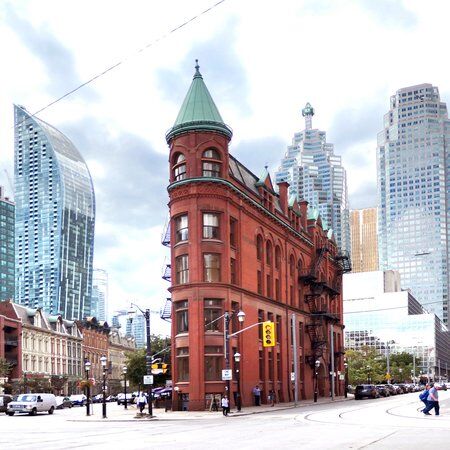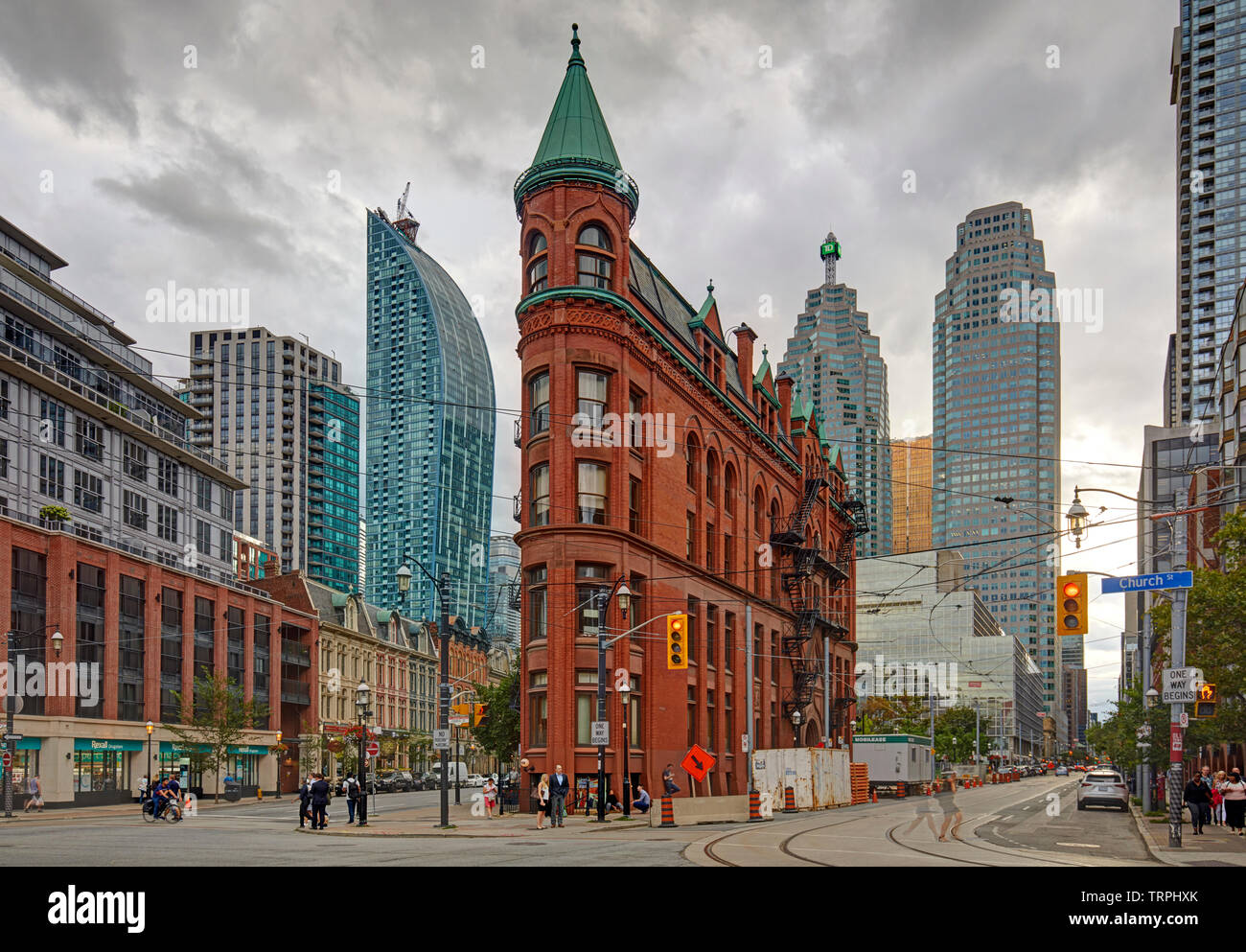Gooderham Building Weather: Best Times to Visit This Historic Site.: Seasonal Weather and Nearby Attractions Can Make It Memorable.
Gooderham Building Weather: Best Times to Visit This Historic Site.: Seasonal Weather and Nearby Attractions Can Make It Memorable.
Blog Article
Discover the Rich Background Behind the Gooderham Building in Toronto
The Gooderham Structure, an exemplary manifestation of Richardsonian Romanesque architecture in Toronto, has a fabled past that expands past its striking red block frontage. Appointed by the influential Gooderham and Worts distillery in 1891, this building has actually played a critical duty in forming the city landscape of the St. Lawrence Market area.

Origins of the Gooderham Structure
Constructing a long lasting heritage, the Gooderham Structure, likewise known as the Flatiron Building, emerged as an icon of Toronto's architectural development in the late 19th century. The structure's origins trace back to 1891 when it was appointed by the Gooderham and Worts distillery, one of copyright's largest distilling companies. Developed by architect David Roberts Jr. Gooderham Building address., the structure was uniquely positioned at the crossway of Front and Wellington Streets, capitalizing on a triangular whole lot developed by the merging of these thoroughfares
The structure's construction made use of local red block and terracotta, developing an unique visual that enhanced the burgeoning cityscape. Initially planned to house the Gooderham and Worts offices, the building represented the prosperity of the distillery, which had become a significant factor to Toronto's economy. Notably, the completion of the Gooderham Structure coincided with a duration of quick urbanization that identified the era.
The establishment of this architectural gem not just showcased innovative design but additionally prepared for future advancements in Toronto. Today, it stands as a testament to the city's abundant history and flexibility, remaining to bring in visitors and admirers from around the world.
Architectural Value
The building relevance of the Gooderham Building prolongs past its distinctive flatiron form, reflecting the innovative spirit of late 19th-century design. Finished in 1892, the structure exhibits the Richardsonian Romanesque design, defined by its robust stonework, rounded arches, and intricate outlining. The vibrant use of different materials, particularly the warm red brick and sedimentary rock accents, boosts its visual appeal and demonstrates the craftsmanship of the period.
The building's three-story design is noteworthy for its harmonious percentages and stylish cornice, which contribute to its famous silhouette against the Toronto skyline. The narrow whole lot on which it stands presented distinct difficulties, yet the engineers, in this situation, made a framework that maximized the offered area while keeping aesthetic equilibrium.
In Addition, the Gooderham Structure is a testimony to the adaptability of building design in city settings. Its enduring presence among contemporary growths illustrates the value of preserving historical architecture as a way of honoring a city's past. Today, it continues to be a beloved landmark, mirroring both the architectural patterns of its time and the progressing story of Toronto as a vibrant metropolitan center.
Role in Toronto's Advancement
Emerging as a principal in Toronto's city landscape, the Gooderham Building added substantially to the city's advancement throughout the late 19th century. Created in 1892, this iconic towers stood for not just the building ambitions of the moment but additionally the burgeoning economic landscape of Toronto. The building was at first designed to work as a stockroom for the Gooderham and Worts distillery, which was among the biggest distilleries in the British Empire. Its critical area at the junction of Front and Wellington Streets helped with the motion of items and solutions, underscoring the area's importance in the city's commercial activities.
As the city expanded, the Gooderham Building came to be a crucial part of the St. Lawrence Market location, which was a hub of trade and business. Its special architectural design and noticeable visibility drew interest, influencing the style of subsequent structures in the area. Moreover, the building's survival through different economic shifts why not try this out and city developments mirrors the strength and flexibility of Toronto's historical landscape. Basically, the Gooderham Structure is not simply an architectural site; it played an essential function fit Toronto's identification and financial growth during a transformative period in its history.
Cultural Effect and Tradition
Gooderham Building's distinct architectural design and historical value have actually left an enduring mark on Toronto's social landscape. As one of the city's most well-known sites, its distinct flatiron shape and detailed brickwork exemplify the Victorian architectural trends of the late 19th century. This framework not only acts as an aesthetic anchor in the St. Lawrence area yet likewise embodies the spirit of a blossoming city during a period of economic development.
The building has ended up being a symbol of Toronto's rich history, inspiring local musicians and photographers who seek to record its beauty. Its visibility has cultivated a sense of neighborhood identification, adding to the story of metropolitan advancement. Additionally, the Gooderham Structure has played a crucial role in the tourism market, bring in site visitors eager to explore its storied past and architectural elegance.
Along with its aesthetic allure, the structure encapsulates a narrative of strength and adjustment, as it has transitioned with numerous usages over the decades - Gooderham Building address. Thus, the Gooderham Structure stands not only as a monument of architectural importance yet additionally as a testament to the advancing social heritage of Toronto

Repair and Preservation Initiatives
Numerous repair and conservation initiatives have actually been embarked on to make sure the Gooderham Structure remains an essential part of Toronto's architectural heritage. Initially completed in 1892, the structure has actually undergone significant restorations to attend to structural issues while retaining its historical stability. The most notable restoration took place in the late 20th century when the building was carefully reconditioned to meet modern-day safety requirements without endangering its initial style elements.
These efforts included repairing the unique red-brick frontage, bring back the iconic triangular form, and maintaining the intricate masonry information. In addition, the structure's inside has actually seen careful updates that value its historic relevance, guaranteeing that initial features such as wood light beams and attractive moldings are kept.
The Gooderham Building is currently safeguarded as a designated heritage home under the Ontario Heritage Act, which helps guard it from improper modifications. Area involvement has actually played a critical duty in these preservation efforts, with neighborhood advocacy teams elevating awareness about the building's historical relevance. Consequently, the Gooderham Building stands not just as a practical space but also as a testament to Toronto's abundant architectural history and sustaining cultural tradition.
Verdict

Please visit one of our local supporters - Gamerama And The Repair Store - Iphone Repairs Toronto
Report this page